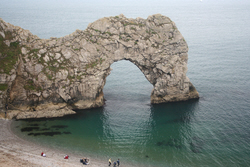Durdle Door...
|
Durdle Door is possibly the most iconic feature of the Dorset coast. It’s been painted, photographed, used on TV and in the movies. It has also made national news.
All of which isn’t bad for what is essentially a rock with a hole in it! But that’s a bit like saying St Paul’s Cathedral is an interesting pile of stones. Believe it or not, Durdle Door and St Paul’s are more closely related than you might think. One may be in the middle of the Nation’s capital city and the other poking its nose into the English Channel, but both are made from Portland Stone. It’s true that one was built by an army of stonemasons and the other carved by the sea, nonetheless, they are hewn from the same, very special, Jurassic limestone that runs all along this part of the Dorset coast, including the Isle of Portland, which gives the stone its name. Whilst St Paul’s may be impressive, nature’s stone mason has achieved something just as inspiring from the same materials - if not more so! The stretch of coast of which Durdle Door is part, will take your breath away, in more ways than one! By any yardstick this is a serious piece of coastline, cliffs and coves, beaches and promontories, landscapes and seascapes. But to get the best out of them you have to put in some effort! You can get to Durdle Door by walking along the beach from “Dungy Head” near Lulworth Cove, but walking on shingle is a hard slog and for your effort you get a view of the sea on one side and the bottom of a cliff on the other! The alternative route is an even harder slog, but takes an aerial path, which rises steeply from the Lulworth Cove car park and provides an awe inspiring view of what happens when undulating Dorset limestone meets 185 million years of erosion by the sea. It’s not an easy walk, but it is well worth it. The view across St Oswalds Bay towards Durdle Door and Swyre Head and Bat’s Head beyond is all a cliff-top view should be: white cliffs, rolling green hills that layer and overlap themselves into the middle-distance and, of course, there’s the sea. The walk from Lulworth to Durdle Door is one of those treks that never looks the same twice. Clear, crisp blues and greens one day and wild greys and white-topped waves the next. It’s not a particularly long walk, but it is one which deserves to be treated with a degree of respect. It is steep, can be slippery and skirts some fairly high and unprotected cliffs in places - which have been known to fall down! So take care. The descent to Durdle Door itself is also challenging, with lots of rough-cut and narrow steps, but once there, you find yourself on a gently curved and fairly sheltered shingle beach, with clear water and one of the best known pieces of empty space on the South Coast, the one that makes the doorway of Durdle Door. The beach can get busy in summertime, and the walk from Lulworth is popular at most times of the year. But you’ll always find somewhere to sit and marvel at what nature has achieved. You’ll be amazed that Durdle Door stays up. And one day, no doubt, it will fall into the sea and become just another rock. Hopefully it will be at least a few thousand years before it does so. In the meantime, this magnificent and gravity defying piece of Dorset and the landscape around it has inspired writers to write, painters to paint and film makers to use it as a backdrop to their stories. More recently it has also inspired a “tomb-stoner” to jump from the top of the arch with predictably catastrophic results. Whilst it’s one way to get on the national news, it’s a piece of publicity Durdle Door and Dorset could have done without. So if you think that might be the sort of thing you’d like to try, don’t! One way or another, you’re likely to pay a very high price. So, there you go, Durdle Door: a hole surrounded by rock; a lovely beach; and a walk with a purpose. For many locals it’s what Sunday afternoons were made for! And an excellent way to burn calories! |
Durdle Door: a hole surrounded by rock; a lovely beach; and a walk with a purpose. "
|





